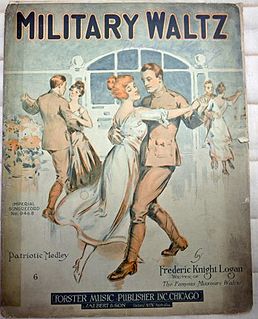
The Nation's Call for Humanity and Right is a World War I song written by N.A.W. Carty. It was published in 1918 by N.A.W. Carty in Lawrence, MA. The sheet music cover depicts a sailor and a soldier flanking a civilian holding a flag.

General Pershing: is a march composed in 1918 by Carl D. Vandersloot and published by Vandersloot Music Publishing Company.
Lafayette is a World War I song written and composed by Mary Earl, which was a pseudonymn of Robert A. King. It was published in New York, New York by Shapiro, Bernstein, & Co. in 1918. The sheet music cover, illustrated by Albert Barbelle, depicts soldiers marching with fixed bayonets below a statue of Lafayette in silhouette.
Here They Come is a World War I song in the style of a march written and composed by Arthur Bergh. It was published in 1917 by Jos. W. Stern & Co. in New York, NY. The sheet music cover, illustrated by Starmer, has a large photo of troops parading down a city street.

"I Wonder Who's Knitting for Me?" is a World War I song written by Raymond Leveen and composed by Jessie Winne. It was published in 1917 by Winne Music in New York, NY. The sheet music cover, illustrated by Starmer, depicts a soldier imagining a women knitting for him, and features an inset photo of Bert Fitzgibbons.

"I'm Crazy Over Every Girl In France" is a World War I song written by Alfred Bryan and composed by Pete Wendling and Jack Wells. The song was published in 1917 by Waterson, Berlin, & Snyder Co., in New York, NY. The sheet music cover, illustrated by Barbelle, depicts a soldier standing against a sea wall with a woman on top of the wall, her arm on his shoulder watching another girl walking by and features battleships in the background.

"I'm Proud to be the Sweetheart of a Soldier" is a World War I song written and composed by Mary Earl. This song was published in 1918 by Shapiro, Bernstein & Co. Inc., in New York, NY. The sheet music cover, illustrated by E. E. Walton, depicts a young woman in a sailor outfit holding a picture of a soldier.

"I'm Hitting The Trail to Normandy: So Kiss Me Goodbye" is a World War I song written and composed by Charles A. Snyder and Oscar Doctor. The song was published in 1917 by Snyder Music in New York, NY. The sheet music cover, illustrated by E.H. Pfeiffer, depicts a soldier kissing a woman good-bye with an inset photo of Paul Elwood.
"It Won't Be Long Before We're Home" is a World War I song in the style of a march. It was written by Paul Cunningham and composed by Joseph E. Howard. This song was published in 1918 by M. Witmark & Sons, in New York, NY.
"Give a Little Credit to the Navy" is a World War I song written by Buddy DeSylva & Gus Kahn and composed by Albert Gumble. This song was published in 1918 by Jerome H. Remick & Co., in Detroit, MI.

"Military Waltz" is a World War I song composed by Frederic Knight Logan. This song was published in 1917 by F.J.A. Forster, in Chicago Illinois. The sheet music cover features three soldiers dancing with women in a ballroom.
While You're Over There in No Man's Land, I'm Over Here in Lonesome Land is a World War I song written by Jessie Spiess and composed by Jack Stanley. The song was first published in 1918 by Will Rossiter in Chicago, Il. The sheet music cover, illustrated by Starmer, features a woman knitting with a battle scene above.

Someone Is Waiting For You is a World War I song written and composed by Al Piantadosi. The song was first published in 1917 by Al. Piantadosi & Co., Inc. in New York, NY.The sheet music cover features an older woman sitting by an open door of a rustic home.
Then You Can Come Back To Me is a World War I song written and composed by Wolfe Gilbert & Anatol Friedland. The song was first published in 1918 by Gilbert & Friedland, Inc., in New York, NY. The sheet music cover depicts silhouetted soldiers marching with pennants labeled Peace, Victory, and Democracy.
We'll Carry The Star Spangled Banner Thru The Trenches is a World War I song written by Daisy May Pratt Erd. The song was first published in 1917 by Lang & Mendelsohn in Boston MA. The sheet music cover depicts soldiers advancing over barbed wire with a flag waving.
We'll Never Let Our Old Flag Fall is a World War I song written by Albert E. MacNutt and composed by M. F. Kelly. The song was first published in 1915 by Chappell & Co., in New York, NY. The sheet music cover was illustrated by Starmer and features words with an eagle on a shield.

The Finest Flag That Flies is a World War I song written by Joseph H. Hughes and composed by Harry Richardson. The song was self-published in 1914 by Joseph H. Hughes in Saginaw, MI.
Under the American Flag is a World War I song written by Andrew B. Sterling and composed by Harry Von Tilzer. The song was first published in 1915 by Harry Von Tilzer Publishing Co. in New York, NY. The sheet music cover features a man hugging a woman with an inset photo of Harry Von Tilzer.
Welcome Home is a World War I song written by Bud Green and composed by Edward G. Nelson. The song was first published in 1918 by A.J. Stasny Music Co., in New York, NY. The sheet music cover depicts soldiers being welcomed home by men and women.
Mary F. Carty was a musician.











